Lab Spotlights — Communications & Signal Processing
Big Data and Signal Processing Lab
Christos Thrampoulidis
Network and Information Sciences Lab
Ramtin Pedarsani
Signal Compression Lab
Kenneth Rose
ViVoNets Lab
Jerry Gibson
Big Data and Signal Processing Lab
Christos Thrampoulidis
At the Big Data and Signal Processing Lab we do research at the intersection of high-dimensionalstatistics, mathematical optimization, signal-processing, and aspects of learning. Our work involves physical modeling, algorithm design, as well as building mathematical frameworks of analysis. Some of our ongoing research projects are:
Structured signal-recovery in high-dimensions
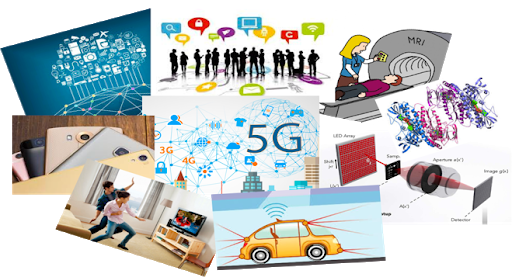
A challenge in big data problems is that typically the ambient dimension of the signal of interest is large (e.g. high-resolution images, gene expression data from a DNA microarray, social network data, massive mimo, etc.), yet is such that its desired properties lie in some low-dimensional structure (sparsity, low-rankness, clusters, etc.). To address this challenge, our lab’s goal is to come up with algorithms, which reveal these structures, and which further enjoy the following favorable features: (a) computational efficiency; (b) the ability to reliably estimate the unknown signal from a compressed number of observations; (c) flexibility to adjust to different measurement models (such as outliers, quantized observations, misspecified models, etc.); and (d) rigorous theoretical performance guarantees. In this line of research, we are also exploring and studying the premises and limitations of recently proposed data-driven recovery methods for exploiting structure.
Fundamental limits of non-smooth convex relaxation-based inference
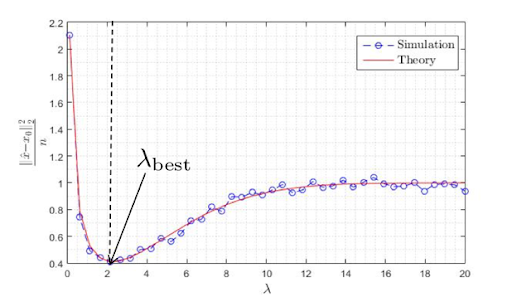
Non-smooth convex optimization based inference has been around for 20 years and has enjoyed great success in practice. Despite progress towards theoretical guarantees on their performance, results still are (i) rather loose, which yields our understanding not comparable to more traditional topics in statistical estimation, and (ii) limited to the vanilla linear regression model, which imposes limitations on their applicability. Hence, our goal is threefold: (a) we build theoretical frameworks that allow to determine the fundamental limits and access the optimality of these algorithms; (b) we derive precise performance guarantees, which we use towards algorithmic improvements; (c) we extend algorithms and theory to problems with quadratic (aka phase-retrieval) and other nonlinear measurement models. In this line of research, we combine tools from empirical process theory, high-dimensional probability, convex analysis, information-theory and statistical physics.
Principles of lens-less cameras for imaging applications
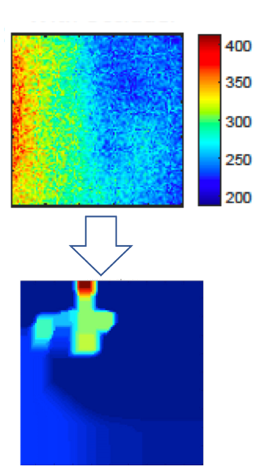
Many modern imaging systems operating at optical and higher frequencies use coded apertures. In these systems, the traditional lens in the aperture is replaced with a spatial mask that selectively blocks portions of the light from reaching the sensor. Yet, while this is an increasingly important imaging modality—one with a long history dating back to the earliest pinhole cameras, but with many modern applications such as in wearable devices, non-line-of-sight (NLOS) imaging systems, etc.—typical mask designs are guided by heuristics and/or numerical procedures. Our goal is to examine the fundamental limits and tradeoffs in the design of such systems under simple but meaningful propagation and sensor models. Here, we also seek to establish connections to other contemporary computational imaging applications such as passive NLOS imaging.
Professor Thrampoulidis's:
Network and Information Sciences Lab
Ramtin Pedarsani
Network and Information Sciences Lab aims at developing provably efficiently algorithms for practically-relevant problem spanning from the control of large-scale stochastic networks to distributed computation and machine learning. The lab’s current main areas of research focus are:

Distributed Computation and Machine Learning
Distributed machine learning algorithms that dominate the use of modern large-scale computing platforms face several types of randomness, uncertainty and system noise. These include straggler nodes, system failures, maintenance outages, and communication bottlenecks. In this project, we view distributed machine learning algorithms through an information-theoretic and coding-theoretic lens. Our goal is to understand fundamental trade-offs in distributed computation between latency of computation, redundancy in computation, communication bottlenecks and storage capacities, and to develop distributed algorithms with robustness against various sources of uncertainty in the system.

Analysis and Control of Large-Scale Stochastic Networks Large-scale
Networked infrastructures such as transportation systems and data centers are rapidly growing in size and demand. Given the new challenges brought about by such networks, we design novel scalable tools for the analysis and control of them. Our goal is to develop mathematical models for complex networks that span diverse application areas from transportation networks with mixed autonomy to data centers, and to design simple, distributed, and robust scheduling algorithms that maximize the efficiency of the network, and are robust to the unknown and time-varying parameters of the network.
Sparse Recovery of High-Dimensional Signals
The past several years have seen a new approach to the recovery of high-dimensional signals, where a few sketches of the signal retain sufficient information for an approximate sparse recovery. This approach has found numerous applications in the areas of signal processing, imaging, data stream computing, etc. Our focus is to exploit tools from modern coding theory to design fast and robust reconstruction algorithms for a variety of problems including compressed sensing, compressive phase retrieval and group testing.
Professor Pedarsani's:
- Network and Information Sciences Lab
- Personal Website
Signal Compression Lab (SCL)
Kenneth Rose
SCL research covers a wide spectrum of topics in signal compression and related areas, and is a confluence of both theoretical foundations, and practical algorithms and applications.
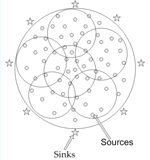
Theory and Methods for Source Coding and Networking: Research under this topic spans both information and estimation theories, with recent emphasis on joint source-channel coding and distributed source coding. Specific problems we are currently focused on include: Achievable rate-distortion region and communication cost minimization for a general multi-hop network with correlated sources and multiple sinks (as in the figure), via joint compression-routing scheme called dispersive information routing (DIR); Developing new communication schemes for emerging network applications with low delay and low energy constraints based on the general "analog networking” methods which achieve optimality at low delay and robustness to varying channel conditions.
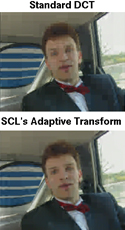
Image/Video Coding and Processing: Research under this topic spans image/video coding and transmission, bio-image informatics, and image/video tracking. Specific focus problems include: Jointly optimal spatial transform and intra-prediction (quality improvement depicted in the figure); Spatio-temporal prediction based on non-separable Markov models; Optimization frameworks, adaptive to time varying network conditions, for optimal scalability in video coders (covering bit-rate, encoding/decoding delay and spatial resolution scalability); Object tracking & 3D tracing in bio-image data via probabilistic graphical models.
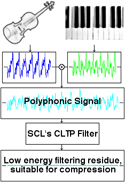
Audio Coding and Processing: Research under this topic spans audio coding and networking. Specific focus problems include: Unified coding paradigms for diverse types of aural signals; Cascaded long term prediction (illustrated in figure) for compression and frame loss concealment; Optimization algorithms for efficient coder design and resource allocation (bitrate, encoding/decoding delay and complexity); Common Information framework-based optimal coding for layered storage and transmission
Professor Rose's:
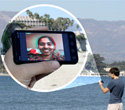
ViVoNets Lab
Jerry Gibson
Research in the ViVoNets Lab is concerned with all aspects of the transmission and processing of voice, audio, still images, and video for communications over multihop, wireless, heterogeneous networks, with a particular emphasis on handheld devices and highly mobile broadband networks.
- Low-Delay Low-Complexity Multimode Tree Coder for Speech: Most voice codecs on handheld devices trade increased delay and complexity for acceptable voice communications quality. These techniques reduce battery life and cause "talkover" in mobile to mobile calls and calls through heterogeneous networks. Our current research is concerned with developing low delay/low complexity speech codecs and performance bounds on the best known codecs. These bounds are used to analyze the performance of existing codecs and to guide future improvements in voice codec design.
- High Dynamic Range (HDR) Video for Handhelds: Our research on HDR video uses signal processing to compensate for the hardware limitations of handheld devices and harsh outdoor lighting conditions. Recent work includes using motion estimation and filtering to combine differently exposed frames, while mitigating ghosting and registration artifacts. The result is improved color and contrast in poorly lit environments.
- Handheld 3D Video Communications: Stereoscopy enhances realism by presenting different views to each eye, producing an illusion of depth. New glasses-free, autostereoscopic displays have recently appeared on handheld devices. Our research is concerned with achieving 3D video communications by adding a front-facing stereo camera adjacent to the autostereoscopic screen. A key difficulty is finding a balance between "deep" 3D perception and viewing comfort. Ongoing work investigates optimal stereo camera placement and automatic disparity remapping to maintain viewing comfort.
- Low-Complexity Video Encoding and High-Complexity Video Decoding: Most video compression methods have a high-complexity encoder and a low-complexity decoder. This structure is suitable for video streaming and entertainment broadcast applications, which have few expensive transmitters and many inexpensive receivers. In contrast, unmanned aerial vehicle (UAV) reconnaissance and video surveillance require low-complexity video encoders, but can allow highly complex decoders at central processing stations. Our recent work includes the development of a low-complexity video encoder suited for UAVs, as well as a high-complexity video decoding algorithm.
Professor Gibson's:
RE Touch Lab
Yon Visell
Advanced Graphics Lab
Pradeep Sen
Center for Bioimage Informatics
B.S. Manjunath
Wireless Communications and Sensornets Lab
Upamanyu Madhow
RE Touch Lab
Yon Visell
Dr. Visell's research focuses on haptic engineering, robotics, and the mechanics and neuroscience of touch. His work is motivated by creative applications in haptic human-computer interaction, sensorimotor augmentation, and interaction in virtual reality.
The lab's main areas of research include:
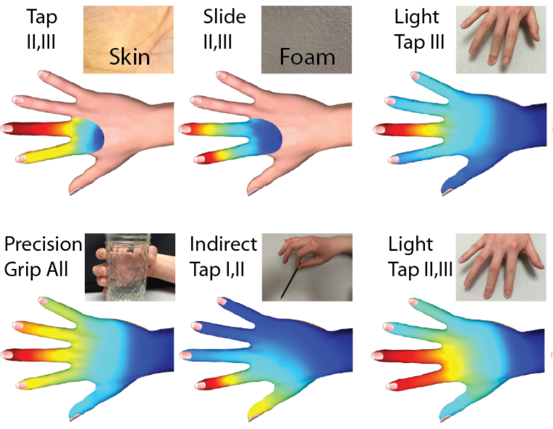 Biosignals and Biomechanics of Touch
Biosignals and Biomechanics of Touch
This research aims to shed light on, and take advantage of, the fundamental biophysical and biomechanical mechanisms of touch interaction. By examining physical phenomena at a variety of length and time scales, we aim to explain the physical basis of active touch sensing and interaction, and to utilize this knowledge in order to engineer new technologies and devices for computationally simulating the feel of touched objects, and for touch sensing and feedback in robotics, virtual reality, and biomedical applications.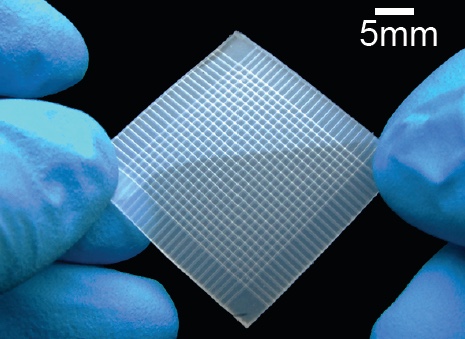 Soft Electronics and Wearable Robotics
Soft Electronics and Wearable Robotics
Soft robotics is an emerging area of engineering that seeks to electronically animate and control soft functional materials, including soft polymers, liquids, and other continuum mechanical systems, in order to enable unprecedented control over the morphology, shape, size, and kinematics of continuum robotic systems. This research is urgently needed in order to enable robotic systems that can safely interact with living systems and function in complex, uncertain, or human-built environments.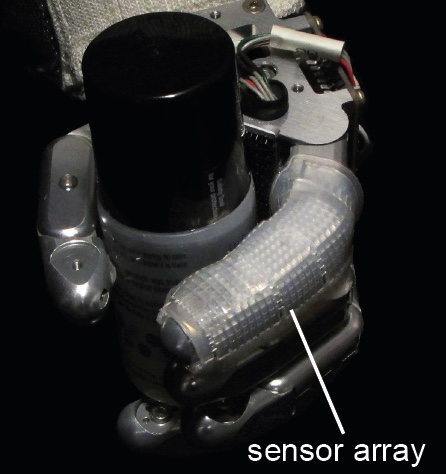 Active Touch Sensing in Humans, Robots, and Animals
Active Touch Sensing in Humans, Robots, and Animals
Major challenges are involved in actively sensing and interacting with the world via touch, whether the latter is performed technologically or biologically. Active touch sensing is interacting with, and recovering information from, the world by ‘touching’ rather than ‘being touched’. This work includes the engineering electronic and biological systems for tactile sensing, sensorimotor control and information processing in humans, animals, and robots, and applications to the design of robotic systems.
Professor Visell's:
Advanced Graphics Lab (AGL)
Pradeep Sen
At the Advanced Graphics Lab, we work on problems in computer graphics and computational imaging. These include:

Improved Algorithms for Image Synthesis: Image synthesis is the problem of generating an image from scene data that includes geometrical models, surface textures, and camera and light properties. In our lab, we work on new algorithms for image synthesis, from high-end algorithms that could be used to produce photorealistic images for feature films, to extremely fast algorithms that could be used to render scenes in videogames or other interactive applications. Our work combines ideas from signal processing, applied math, and computational methods to improve the speed and quality of rendered images.

Better Imaging Techniques: Digital photography is changing the way we communicate, socialize, and document events around us, but it still has several shortcomings. In our lab, we develop new technology and algorithms that improve photography or break its traditional paradigms. One example is our recent work to improve the acquisition of high-dynamic range (HDR) images with a conventional camera. Standard digital cameras have a small dynamic range and cannot capture the wide range of illumination of a scene in the way our eyes can (we can see the bright and dark parts of a scene simultaneously). Although researchers have developed techniques to compute HDR images from a set of sequential images at different exposures, these techniques usually only work robustly for static scenes. In our lab, we have developed a new optimization-based framework that reconstructs high-quality HDR images from a set of standard images of a dynamic scene. Algorithms like this could change the way people take pictures in the future.
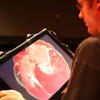
Novel modes of Interaction: As we develop new technologies for sensing, display, and interaction, we need to study new ways to use them to solve real-world problems. In this research thrust, we explore ways to leverage new technologies for applications in visualization, training, and entertainment. These new techniques are more immersive and more intuitive than traditional interaction.
Professor Sen's:
- Advanced Graphics Lab (AGL)
- Personal Website

Center for Bioimage Informatics
B.S. Manjunath
Brain Science has attracted the attention of many biology research groups around the world. With recent advances in imaging, it is possible to harvest large amounts of image data through in vitro and in vivo procedures at multiple scales. As a result the need to develop computational techniques that help biologists interpret the data is crucial.
The Center for Bio-Image Informatics is an interdisciplinary research effort between Biology, Neuroscience, Computer Science, Statistics, Multimedia and Engineering. The overarching goal of the center is the advancement of human knowledge of the complex biological processes which occur at various resolutions. To achieve this core objective, the center employs and develops cutting edge techniques in the fields of imaging, pattern recognition and data mining for analyzing data using different modalities.
- Coarse Resolution: to analyze Magnetic Resonance Imaging (millimeter resolution) data to understand the morphology and functionality of the human brain better. Discriminative data analysis methods are employed for getting an understanding of regions that get affected due to a certain condition (e.g., psychopathy).
- Intermediate Scale: techniques to understand the distribution of neuronal spines from confocal images (micrometer resolution) are presented. Statistical modeling of the spine distributions before and after treatment could yield valuable insights into alterations of spine behavior as a result of the treatment (with micro RNA in our case).
- Finest Level: we develop methods to help biologists work with electron micrograph data (sub-nanometer resolution). Segmentation methods employing conditional random fields with learned topological priors helps trace neuronal processes over depth.
Professor Manjunath's:

Wireless Communications and Sensornets Lab
Upamanyu Madhow
Our lab’s main focus is on new system concepts and architectures for wireless communication and sensor networks, with smaller efforts in areas such as multimedia security and neuroimaging. Some examples of recent and ongoing research efforts are as follows:
- 60 GHz networking: The large amounts of unlicensed bandwidth available in the 60 GHz band enable a quantum leap in wireless communication, to multiGigabit speeds, but the small carrier wavelength (order of magnitude smaller than WiFi) and the high data rates (order of magnitude higher than WiFi) create unique design challenges. Examples of recent work include interference analysis and medium access control protocols for networks with highly directional links, signal processing with constraints on analog-to-digital conversion, space-time channel modeling, and prototypes demonstrating spatial multiplexing in line-of-sight environments.
- Collaborative communication and signal processing: Examples of recent work include collaborative beamforming, where multiple transmitters form a distributed antenna array to increase range and power efficiency, and collaborative signal estimation, where multiple sensors pool observations to better reconstruct a common signal seen through different dispersive channels at different sensors.
Our research often involves interdisciplinary collaborations, since we tackle hard problems requiring diverse expertise. Current collaborators include faculty from computer science, controls, electronics, and psychology.
Professor Madhow's: